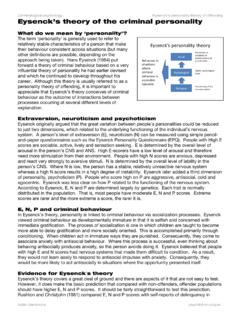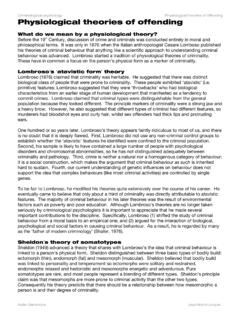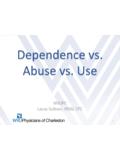Transcription of Criminological psychology Punishments and treatments for ...
1 Criminological psychology Punishments and treatments for offending Aidan Sammons Non-custodial sentencing Alternatives to imprisonment Apart from imprisonment, judicial systems typically have a range of non-custodial sentencing options at their disposal. The options available vary considerably across different societies. In the UK the most frequently used non-custodial sentences are: Fines: the offender is required to pay a specified sum of money to the authorities. probation : the offender is required to be supervised and regularly checked for a specific period. Reparation & restitution: the offender is required to undertake specified activities to repay either society or his victim for his criminal activities. There is substantial evidence that in many cases non-custodial sentences are at least as effective as custodial ones, besides having significant additional advantages.
2 Fines A fine is a sum of money an offender is required to pay to the authorities. The amount is generally set by the court but there are usually statutory limits one the size of the fine. According to Caldwell (1965) fines have three principal advantages over other Punishments . First, the system is economical: it costs little to administer and generates a source of revenue that can be used to offset the cost of running the judicial system (amongst other things). Second, fines do not stigmatise the offender or their family and they may avoid some of the undesirable effects of imprisonment, such as loss of employment. Third, a fine may be imposed where other Punishments are inappropriate, such as when a business, rather than an individual, has broken the law. Walker and Farrington (1981) found that fines led to lower rates of reoffending than probation or a suspended prison sentence and Feldman (1993) suggests that they lead to lower reconvictions rats for first offenders than the alternatives.
3 However, Putwain and Sammons (2002) indentify two potential problems with fines as a judicial sanction: They may be paid by the offender s friends or family, thereby lessening their impact on the offender themselves. They may be seen as an operating cost of offending. That is, paying fines may be seen as preferable to altering offending behaviour. For example, a company that pollutes the environment may calculate that it is cheaper to pay the fines for pollution than to clean up its act. In both cases, the imposition of a fine may have minimal impact on future offending. probation When an offender is put under probation , they are released into the community with the proviso that they must meet certain conditions or risk further punishment . A probation order might be given with a suspended sentence or as a condition of early release from prison. Violation of the terms of the probation order would consequently mean (a return to) custody.
4 The conditions imposed generally require that the offender is under the supervision of a probation officer with whom he is expected to meet regularly. Other conditions might involve taking part in particular activities or employment or submitting to regular drugs tests. (NB. in England and Wales, probation orders are now known as community rehabilitation orders ). probation seems to be at least as effective as imprisonment at preventing recidivism. Oldfield (1996) studied 857 offenders in Kent. Of those given custodial sentences 63 per cent had reoffended within five years. By contrast, only 41 per cent of those given probation reoffended within the same period. Roshier (1995) produced very similar results in Cleveland (64 vs. 41 per cent) but found that community service was slightly more effective, with 37 per cent of this group reoffending. Criminological psychology Punishments and treatments for offending Aidan Sammons probation has some additional advantages over imprisonment.
5 Like a fine, probation avoids some of the stigmatizing and disruptive effects of imprisonment. It also costs considerably less. Although estimates vary, it is unlikely that probation costs more than a tenth of the cost of imprisonment. Since the cost of imprisonment currently runs at around 38,000 per prisoner per year this represents a very significant saving. It should be noted, however, that the effectiveness of probation depends heavily on the content of the programme (Oldfield, 1996) and success is substantially more likely when this is tailored to the circumstances of the offender. So whilst probation is a cheaper option than imprisonment it must still be properly resourced. Reparation and restitution Reparation and restitution-based sentences require the offender to undertake activities that in some way pay back the community or the victim for their crimes. We can distinguish between: Reparation: the offender is required to spend a specified time undertaking activities of benefit to the community.
6 In the UK this was previously called community service and is now called community punishment . Restitution: the offender is required to do things that directly compensate the victim(s) of their crimes. Historically these types of sentence have been used more in the US than the UK (Blackburn, 1993). Schneider (1986) examined the effectiveness of restitution in four different US communities. Offenders were randomly allocated to either restitution or one of its alternatives and followed up for three years. Restitution emerged as marginally more effective than other types of sentence but there were considerable variations depending on the nature of the community and the way the programme was managed. General considerations There are significant difficulties in evaluating the relative effectiveness of different types of non-custodial sentence. First, many variables influence offending, of which the type of punishment given is only one.
7 McDonald (1989) observes that offenders decisions to reoffend involved weighing up potential benefits against an entire gauntlet of punishment involving the effects of arrest, remand, raising bail money, leaning on friends and family for help and so on. The actual judicial sentence was a relatively minor factor in their considerations. Second, it is rarely the case that offenders are randomly assigned to different types of sentence. Rather, the sentence given reflects the nature of the offences, the court s assessment of the risk posed by the offender and a variety of judicial priorities including punishment and incapacitation besides the desire to reform the offender. The apparent effectiveness of different sanctions may reflect these decisions, rather than the effect of the punishment itself. That said, large scale reviews have generally found that non-custodial sentences are at least as effective as imprisonment.
8 Gendreau and Goggin (1996) reviewed 105 studies comparing imprisonment and community-based sentences and concluded that there were no differences in recidivism. This being the case, community Punishments emerge as superior on economic grounds, at least for non-violent offenders, since they cost substantially less than imprisonment. Government statistics also support the effectiveness of non-custodial sentences. Recent data put the one year recidivism rate of those sentenced to community-based Punishments at 36 per cent compared to 59 per cent for those sentenced to short prison terms (Ministry of Justice, 2008). However, it should also be stressed that the effectiveness of non-custodial sentences depends heavily on the programme content. Where there are concerted efforts to address the factors that underpin offending, recidivism rates are lower. Attention should therefore be given to interventions specifically designed to address these factors, including psychological treatments for crime.
9














